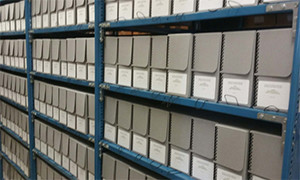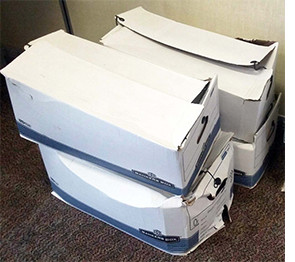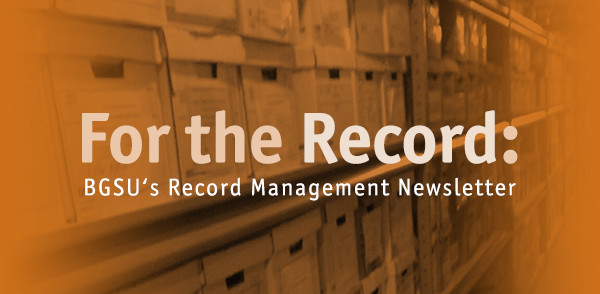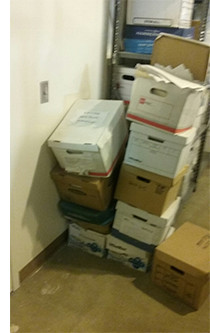|
Issue FAQ — What’s the Difference between a Records Center and an Archives?  Throughout my career I’ve found that there is often confusion about the difference between a records center and an archives. For example, many people have come to use the word “archiving” for many records management activities — some of which actually relate to a records center. So if you’re a little confused by the difference — or if you didn’t even realize there was a difference — you’re definitely not alone.
Throughout my career I’ve found that there is often confusion about the difference between a records center and an archives. For example, many people have come to use the word “archiving” for many records management activities — some of which actually relate to a records center. So if you’re a little confused by the difference — or if you didn’t even realize there was a difference — you’re definitely not alone.Here at BGSU we have both a University Records Center and a University Archives. The University Archives is part of the Center for Archival Collections and is located on the 5th floor of the Jerome Library. It holds over one hundred separate collections of materials representing university administrative offices, academic colleges and departments, student organizations, and more. All of these materials are open to students, faculty, staff and members of the general public for research. Records are accepted into the University Archives because they are judged to have significant historical value and the intent is to keep and preserve them forever. Special acid-free boxes and folders are often used to help in their preservation. In addition, once records are in the Archives, it is the intent that they never leave the building again. Finally, it is the responsibility of the University Archives’ staff to prepare finding aids and other resources (such as box and folder lists) so our patrons know what records can be found in each box.  Boxes line the shelves in the BGSU University Archives. I hope this comparison has clarified some of the differences between an archives and a records center. If you have any questions about what sort of records can be sent to either the University Records Center or University Archives, or the procedures involved, please contact me at csauer@bgsu.edu or 2-9614. Have a question or topic you’d like to see addressed as an Issue FAQ? Please send it to csauer@bgsu.edu. How Do YOUR Boxes Stack Up?  The ultimate fate of most records stored in the Records Center is that they will be destroyed. It may not be for 2 years, 5 years, or 20 years, but eventually, they will be thrown out (shredded actually). So what does it matter what sort of box they are sent to the Records Center in? A great deal actually.
The ultimate fate of most records stored in the Records Center is that they will be destroyed. It may not be for 2 years, 5 years, or 20 years, but eventually, they will be thrown out (shredded actually). So what does it matter what sort of box they are sent to the Records Center in? A great deal actually.For one thing, there’s a good reason why you’re sending the records to the Records Center in the first place — there is a legal, administrative, or fiscal requirement that they be kept for a certain number of years. And it’s up to both you and me to make sure that they remain available and accessible up until the day they’re destroyed. I do my part by keeping a detailed inventory of exactly where each box is located in the Records Center, keeping track of destruction dates so nothing is destroyed prematurely or kept too long, and making sure the Records Center is as secure as possible. You can do your part by making sure the boxes you use are sturdy and well-labeled. A few helpful hints:
 How do you deal with electronic records? Print them out? Delete them? Ignore them? As tempting as that last option is, it’s not a solution. It’s easy to feel overwhelmed with just how many electronic records there are, the variety of formats they come in, how easily they can be changed, and so many other reasons. I’ve recently completed training on dealing with archival electronic records, however, and have come to realize they aren’t as difficult to deal with as they can initially seem. One of the best practice is to start organizing them as soon as they are created; that way they don’t get out of hand.
How do you deal with electronic records? Print them out? Delete them? Ignore them? As tempting as that last option is, it’s not a solution. It’s easy to feel overwhelmed with just how many electronic records there are, the variety of formats they come in, how easily they can be changed, and so many other reasons. I’ve recently completed training on dealing with archival electronic records, however, and have come to realize they aren’t as difficult to deal with as they can initially seem. One of the best practice is to start organizing them as soon as they are created; that way they don’t get out of hand.Here are some other important tips (borrowed from the Council of State Archivists (CoSA)) to keep in mind when dealing with electronic records and electronic communications such as e-mail. As CoSA notes, managing electronic records is like caring for a perpetual toddler: they need regular attention and care in order to remain accessible. Therefore:
|
|


 If at all possible, send over full boxes. Nothing leads to a collapsing box more than being only partially full and having a heavier box on top of it.
If at all possible, send over full boxes. Nothing leads to a collapsing box more than being only partially full and having a heavier box on top of it.